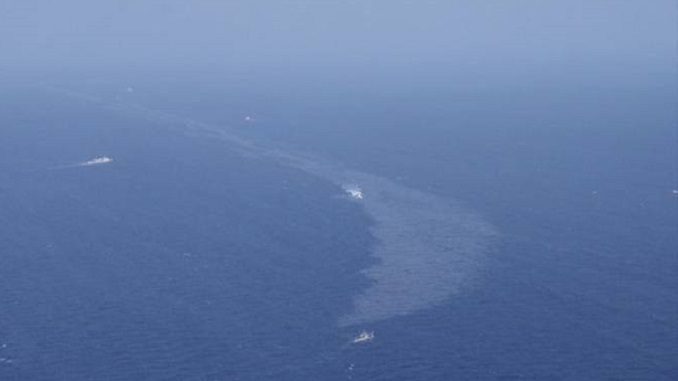
Oil that reached islands in southern Japan earlier this month is highly likely to have come from the sunken Iranian tanker Sanchi, the Japan Coast Guard said on Thursday, Reuters reports. Samples of oily matter that washed up on Feb. 8 on the shores of the Okinoerabu and Yoron islands in the Amami chain were found to be linked to the Sanchi’s sinking, the Coast Guard said.
The Sanchi sank on Jan. 14 after colliding with a freighter on Jan. 6 in the world’s worst oil tanker disaster in decades.
“Oily matter that arrived at the shores of the two islands is extremely likely to be linked to the Sanchi tanker incident, considering the similarity of the oil and the fact that there has not been any marine disaster involving oil spill in the nearby sea area,” a Coast Guard official told Reuters by phone on Thursday.
Black clumps of oily matter first washed up on the shores of Takarajima island on Jan. 28 and other matter has since arrived at 21 other islands in southwestern Japan that are part of a chain of islands that includes Amami-Oshima and Okinawa, areas famous for pristine beaches and reef systems.
The Sanchi, which the Coast Guard said was carrying 111,000 tonnes, or about 810,000 barrels, of condensate – an ultra-light, highly flammable crude oil – sank after several explosions weakened the hull following the collision. Most of the fuel evaporated after the ship caught fire.
The bodies of two sailors were recovered from the ship while a third body was pulled from the sea near the vessel. The remaining 29 crew of the ship are presumed dead.
On Jan. 17, the Chinese government said the sunken tanker had created two oil slicks. Japan’s environment ministry said in January it saw little chance that the spill would reach Japanese shores. Seawater samples taken from Jan. 29 to Feb. 2 at 14 different locations offshore southern Japan detected no oil pollution from the sunken tanker, the Coast Guard said in a statement on Wednesday.
An oil slick continues to be seen near where the Sanchi sank. The slick is located about 315 km (197 miles) west of Amami-Oshima island and is about 700 meters long and 20 meters wide, though oil has been evaporating from the fringes, the Coast Guard said in a statement on Thursday.
“Japanese and Chinese patrol boats have been searching for the missing crew in the area and sailing over the slick to try to dissipate the oil,” it added.
The world’s largest tanker spill in nearly 30 years may be causing a stealthy environmental catastrophe in the East China Sea. Unfortunately, the response to it has been hindered by uncertainties, as well as insufficient capabilities, and lack of leadership and coordination. Six weeks after the spill, its actual and potential environmental impact is still unknown.
On January 6, the Panamanian-flagged, Iranian-owned tanker Sanchi and the Hong Kong-flagged grain freighter CF Crystal collided about 160 nautical miles east of the Yangtze River mouth. The tanker burned for eight days before sinking. The Sanchi’s entire 32-member crew was lost. The ship spilled some of its 111,000 tonnes of highly volatile natural gas condensate cargo and its heavier 8,450 barrels of bunker fuel. The environmental impact of such a massive spill is unknown.
Despite being obliged by the UN Convention on the Law of the Sea to protect the marine environment, both China, in whose 200-nautical-mile exclusive economic zone the accident occurred, and Japan, in whose claimed exclusive economic zone the vessel sank, were slow to respond. Where is the spill now? The Japanese coastguard has reported black globules on nine islands between Okinawa and Kyushu. If the globules are from the bunker fuel, it could mean that the condensate has already come ashore.
The tainting is likely to have a huge impact on fisheries. Some components of condensate can be carcinogenic. Indeed, scientists have already warned consumers to avoid seafood from the area until the relevant governments have analyzed their toxicity and Chinese authorities have banned fishing in the affected area.
